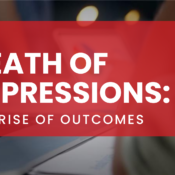/
/
The New Era of Tracking Conversions
As digital marketing services evolve and become more sophisticated, the ability to track results becomes much more complex. We are always trying to find more ways to prove that a specific digital channel is working or that it isn’t, alongside the goal of constantly improving performance and ROI to our client. One of the things we recently did here at TargetClick, as Andrew mentioned in his most recent blog post, was the implementation of what he called The Searchinator. Well, the Searchinator, is actually a software that we are using called Kenshoo.
We began partnering with Kenshoo back in June when we realized we needed to take our paid search efforts to the next level. We researched many different options that gave us many different features and benefits. One thing that we are now able to do with the use of Kenshoo, is to take a deeper look at how we are quantifying the value of our conversions across different channels.
In the past, we were only able to attribute the entire value of a conversion (form lead, phone call, purchase) to the first or last ad or keyword that was clicked on. We are now able to apply much more advanced attribution models to campaign performance data and gain better insight to what is actually driving consumer interest and action.
Before I get started explaining the five different attribution models we can deploy, I want to point out that Kenshoo recently did a study where they examined performance from recent advertising campaigns which were measured by “Last Ad” and then compared to five standard attribution models (which I cover below). They found that “In all five standard attribution models, Facebook advertising was undervalued 10 - 30% relative to Last Ad measurement.”
 Here are the five types of Attribution Models we are able to deploy with our new software.
First Only
The first only attribution model credits just the first interaction (click) a customer has with an advertiser. For example, in a conversion worth $100 that had 5 touch-points with the consumer, only the initial placement would receive the entire $100 credit for the conversion. All others would receive zero credit
Prefer First
The Prefer First attribution model gives the first interaction with the consumer the majority of the credit, and each of the following clicks receives credit in a rules-based, linearly decaying fashion.
Divide Equally
For this model, all interactions are attributed equally against the value of the conversion. So if a conversion is worth $50 where the consumer had 5 interactions, each click would receive $10 in credit
Prefer Last
With Prefer Last attribution, the last ad in the customers journey to conversion receives the majority of the credit, with each preceding interaction receiving credit in a rules-based, linearly decaying fashion.
U-Shaped
This model uses an 80-20 rule to emphasize the first and the last clicks in the conversion path, while giving the middle clicks in long path-to-conversion less credit.
Where am I going with this?
Not only are we able to optimize on this data, we have a really cool widget in our reporting dashboard that allows you to see consumer activity and how they started and finished their process to conversion. Here is a quick snapshot:
Here are the five types of Attribution Models we are able to deploy with our new software.
First Only
The first only attribution model credits just the first interaction (click) a customer has with an advertiser. For example, in a conversion worth $100 that had 5 touch-points with the consumer, only the initial placement would receive the entire $100 credit for the conversion. All others would receive zero credit
Prefer First
The Prefer First attribution model gives the first interaction with the consumer the majority of the credit, and each of the following clicks receives credit in a rules-based, linearly decaying fashion.
Divide Equally
For this model, all interactions are attributed equally against the value of the conversion. So if a conversion is worth $50 where the consumer had 5 interactions, each click would receive $10 in credit
Prefer Last
With Prefer Last attribution, the last ad in the customers journey to conversion receives the majority of the credit, with each preceding interaction receiving credit in a rules-based, linearly decaying fashion.
U-Shaped
This model uses an 80-20 rule to emphasize the first and the last clicks in the conversion path, while giving the middle clicks in long path-to-conversion less credit.
Where am I going with this?
Not only are we able to optimize on this data, we have a really cool widget in our reporting dashboard that allows you to see consumer activity and how they started and finished their process to conversion. Here is a quick snapshot:
 Here are the five types of Attribution Models we are able to deploy with our new software.
First Only
The first only attribution model credits just the first interaction (click) a customer has with an advertiser. For example, in a conversion worth $100 that had 5 touch-points with the consumer, only the initial placement would receive the entire $100 credit for the conversion. All others would receive zero credit
Prefer First
The Prefer First attribution model gives the first interaction with the consumer the majority of the credit, and each of the following clicks receives credit in a rules-based, linearly decaying fashion.
Divide Equally
For this model, all interactions are attributed equally against the value of the conversion. So if a conversion is worth $50 where the consumer had 5 interactions, each click would receive $10 in credit
Prefer Last
With Prefer Last attribution, the last ad in the customers journey to conversion receives the majority of the credit, with each preceding interaction receiving credit in a rules-based, linearly decaying fashion.
U-Shaped
This model uses an 80-20 rule to emphasize the first and the last clicks in the conversion path, while giving the middle clicks in long path-to-conversion less credit.
Where am I going with this?
Not only are we able to optimize on this data, we have a really cool widget in our reporting dashboard that allows you to see consumer activity and how they started and finished their process to conversion. Here is a quick snapshot:
Here are the five types of Attribution Models we are able to deploy with our new software.
First Only
The first only attribution model credits just the first interaction (click) a customer has with an advertiser. For example, in a conversion worth $100 that had 5 touch-points with the consumer, only the initial placement would receive the entire $100 credit for the conversion. All others would receive zero credit
Prefer First
The Prefer First attribution model gives the first interaction with the consumer the majority of the credit, and each of the following clicks receives credit in a rules-based, linearly decaying fashion.
Divide Equally
For this model, all interactions are attributed equally against the value of the conversion. So if a conversion is worth $50 where the consumer had 5 interactions, each click would receive $10 in credit
Prefer Last
With Prefer Last attribution, the last ad in the customers journey to conversion receives the majority of the credit, with each preceding interaction receiving credit in a rules-based, linearly decaying fashion.
U-Shaped
This model uses an 80-20 rule to emphasize the first and the last clicks in the conversion path, while giving the middle clicks in long path-to-conversion less credit.
Where am I going with this?
Not only are we able to optimize on this data, we have a really cool widget in our reporting dashboard that allows you to see consumer activity and how they started and finished their process to conversion. Here is a quick snapshot:
*client information is blurred out for client confidentiality
In this example, we are able to see that a customer searched for the keyword “2013 Honda accord reviews” and landed on our clients site. Then over the next couple of weeks in their research process, they began searching for the client’s actual brand, then converted. If we were to only use “Last Ad” model, we would only be giving the branded search credit for conversion. In this case, we should give credit to the initial search for “2013 Honda accord reviews” as well. This is because it tells us that before the customer found our client’s website, they were unaware of them. Keep in mind that one attribution model may work for one client, but not another. This is a decision that is made for each client, depending on the different channels they are marketing on. As digital marketers, we need to make sure that we have the ability to be versatile in the way we track and value conversions, as each of our clients are unique in what is valuable to them. Being able to do this allows us to make more effective decisions with our clients’ budget, and improve results. If you are interested in seeing a demo or discussing how one of our Search Engine Marketing programs may benefit you, feel free to contact me at doug.drees@mudd.comRecent Posts
Mudd Advertising
Mudd Advertising is Partnering with Equifax
Mudd Advertising
Personalization at Scale—Not Just a Buzzword
Mudd Advertising
The Death of Impressions: The Rise of Outcomes
All Categories
Tags
aia ads
automotive
ctv
digital marketing
direct mail
direct marketing
display
display ads
dynamic inventory display
email
email marketing
EV marketing
facebook
gbp
google analytics
google my business
google my business inventory
google shopping ads
internet marketing
local seo
MUDDid
mudd id
online marketing
pay per click
performance max
pmax
pop
ppc
radio
retargeting
search engine marketing
search engine optimization
sem
seo
social
social media
social media marketing
traditional marketing
traditional media
ux management
vehicle listing ads
video advertising
video production
vla
web ux





